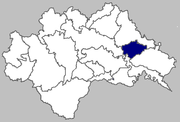
Lipovljani
Encyclopedia

Lipovljani is a municipality in Croatia
Croatia
Croatia , officially the Republic of Croatia , is a unitary democratic parliamentary republic in Europe at the crossroads of the Mitteleuropa, the Balkans, and the Mediterranean. Its capital and largest city is Zagreb. The country is divided into 20 counties and the city of Zagreb. Croatia covers ...
n Slavonia
Slavonia
Slavonia is a geographical and historical region in eastern Croatia...
in the Sisak-Moslavina county
Sisak-Moslavina County
Sisak-Moslavina County is a Croatian county in eastern Central Croatia and southwestern Slavonia. It is named after the city of Sisak and the region Moslavina just across the river Sava. According to 2001 census it is inhabited by 185 thousand people....
. It has a population of 4,101 (2001 census), 85.7% which are Croats
Croats
Croats are a South Slavic ethnic group mostly living in Croatia, Bosnia and Herzegovina and nearby countries. There are around 4 million Croats living inside Croatia and up to 4.5 million throughout the rest of the world. Responding to political, social and economic pressure, many Croats have...
. Other notable minorities are Ukrainians
Ukrainians
Ukrainians are an East Slavic ethnic group native to Ukraine, which is the sixth-largest nation in Europe. The Constitution of Ukraine applies the term 'Ukrainians' to all its citizens...
(4.3%), Slovaks
Slovaks
The Slovaks, Slovak people, or Slovakians are a West Slavic people that primarily inhabit Slovakia and speak the Slovak language, which is closely related to the Czech language.Most Slovaks today live within the borders of the independent Slovakia...
(3%), and Czechs (2.4%). Lipovljani have the oldest Ukrainian Greek Catholic Church
Greek Catholic Church
The Greek Catholic Church consists of the Eastern Catholic Churches which follow the Byzantine liturgical tradition and are thus in full communion with the Bishop of Rome, the Pope.-List of Greek Catholic Churches:...
due to the fact it was founded by early Ukrainian immigrants at the time of the Austria-Hungary Empire.

